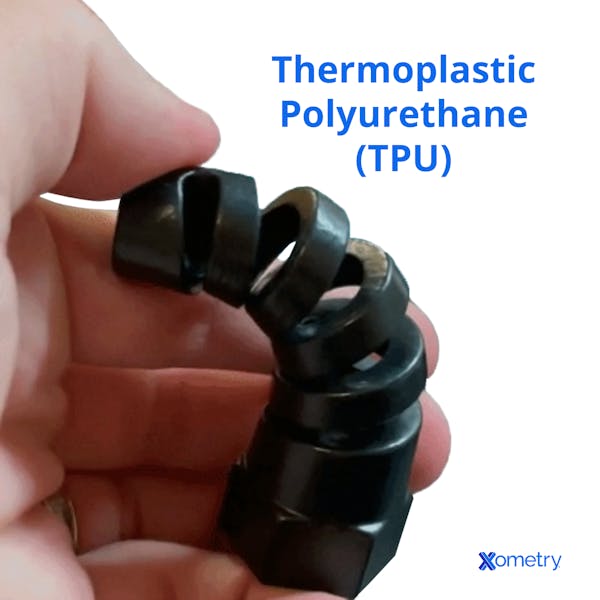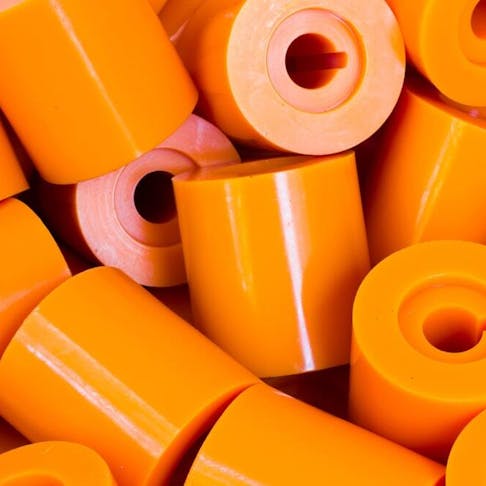TPR, or thermoplastic rubber, is a copolymer that combines the properties of polystyrene (PS) and an elastomeric mid-block, typically butadiene-based. It was developed to provide many of the benefits of synthetic rubber while enabling precise, repeatable processing through injection molding.
TPU or thermoplastic polyurethane is a broad category of polyurethane polymers with properties such as elasticity, transparency, wear resistance, and strong oil resistance. These thermoplastics feature alternating hard and soft polymer segments that give them both strength and flexibility.
This article will further compare TPR vs. TPU, their applications, uses, physical properties, and alternative materials.
What is TPR?
TPR or thermoplastic rubber generally refers to styrenic block copolymers such as SBS or SEBS, often containing around 30% polystyrene by mass and the remainder elastomeric mid-block. It was developed to offer many benefits of synthetic rubber while remaining suitable for precise processing in injection molding. TPR delivers outstanding fatigue resilience, chemical stability, impact strength, and moderate recyclability.
Typical rubbers are synthesized or refined in a partially polymerized form, and then heat is applied to finish the cross-linking process. In TPRs such as SBS or SEBS, the polystyrene forms hard domains that act as physical cross-links within a continuous elastomeric phase, rather than being dispersed as pre-cross-linked rubber powder. Flexibility results from the elasticity of the butadiene component, while the hard polystyrene domains provide structural integrity.
TPR does not match the performance of vulcanized rubbers and is unsuitable for tire compounds due to limitations in heat resistance, dynamic fatigue performance, and wear properties. However, SEBS-based TPRs offer good ozone, weathering, and UV resistance compared to many unsaturated rubbers, though vulcanized EPDM typically exceeds them for long-term outdoor durability.
What is TPU?
TPU polymers are block copolymers with longer, flexible soft segments and shorter, rigid hard segments, which in many grades have higher polarity than the soft segments. Covalent linkages between the two segment types make well-integrated chains that derive properties from both chain elements. By altering the molecular weights and ratios of the constituent parts, a wide range of properties can be derived in chemically (almost) identical materials. The glass transition temperatures (Tg) of the soft and hard segments are generally distinct and can be adjusted through chemical composition to modify performance. These processing issues allow the production of a range of thermal properties of the resulting material family.
The hard segments aggregate through intermolecular attraction to form pseudo-crystalline domains dispersed in the elastic soft-segment matrix. The pseudo-crystalline regions behave as cross-linking elements, which account for the high elastic modulus of the family, whereas the longer, softer chains moderate this effect, allowing a range of hardness/elasticity to be manufactured.
This cross-linking effect diminishes to zero as the glass transition temperature of the harder component is exceeded. The family behaves as a fully thermoplastic material group, suitable for injection molding. While TPUs can be recycled by melting and reforming, the process can reduce chain integrity.

TPR vs. TPU: Applications and Uses
Typical TPR applications by industry include:
- Auto Manufacture: Door and window seals, transmission and suspension parts, fender inserts, trim, instrument panels, ducts, grommets, belts, pipes, mats, and O-rings.
- Construction: Door and window seals, hydraulic seals, and plumbing seals.
- Industrial: Vibration dampers, pipes, manifolds, seals, suspension bushes, shock absorbers, and roof membranes.
- Consumer: Refrigerator seals, handgrip overmolds, mobile phone covers, switch panels, and vibration dampers.
- Medical: Air tubes, syringe seals, breathing masks and plenums, seals, valves, and catheters.
- Electronics: Encapsulation, power leads, high-quality cables, mobile phone shock protection, and seals.
- Footwear and Sports Equipment: Diving flippers, snorkels, masks, ski-pole grips, ski-boot components, and shoe soles.
Typical TPU applications by industry include:
- Automotive: Interior parts requiring good surface finish, durability, and wear resistance. While TPU can be cost-effective compared to certain high-performance engineering plastics, it is generally more expensive than commodity polymers like polypropylene.
- Agriculture: ID tags for animals, valued for flexibility, tear and weather resistance, and wide temperature tolerance. Also used for encapsulating RFID devices.
- Piping and Plumbing: Seal profiles and O-rings, tubes, belts, and hoses. Specialist polymers with optimal melt-flow properties, extrusion-adapted high resistance to hydrolysis by hydraulic and other oils and organics, resistance to compression at high temperatures, high toughness, flexibility, and resistance to tearing.
- Textile: Used for conveyor belts, inflatables, and military equipment. Wide range of processing options, and good mechanical, chemical, and thermal properties.
- Sports Equipment: Extreme flexibility, high-impact and temperature resistance, transparency, and environmental tolerance.
Some sectors use both TPR and TPU, but the materials are rarely interchangeable, as each application relies on a specific property unique to one of them. For example, in the automotive sector, TPRs are often chosen for flexibility and weathering resistance, while TPUs are preferred for resilience, wear resistance, and ergonomic surfaces.
| Property | TPR value (metric) | TPU value (metric) |
|---|---|---|
Property Hardness, Shore D | TPR value (metric) ~10–70 | TPU value (metric) ~55–85 |
Property Tensile Strength, Ultimate | TPR value (metric) 2–35 MPa | TPU value (metric) 28.0–96.0 MPa |
Property Tensile Strength, Yield | TPR value (metric) 1–5 MPa | TPU value (metric) 52–80 MPa |
Property Modulus of Elasticity | TPR value (metric) 0.02–0.68 GPa | TPU value (metric) 0.62–5.50 GPa |
Property Flexural Yield Strength | TPR value (metric) 2.66–24.1 MPa | TPU value (metric) 19.0–95.1 MPa |
Property Flexural Modulus | TPR value (metric) 0.0917–0.814 GPa | TPU value (metric) 0.520–4.50 GPa |
Property Taber Abrasion, mg/1000 Cycles | TPR value (metric) 30–800 | TPU value (metric) 5–25 |
Property Melting point | TPR value (metric) 104–191°C | TPU value (metric) 185–243°C |
Property Coefficient of Thermal Expansion, linear | TPR value (metric) 110–170 µm/m°C | TPU value (metric) 14–56 µm/m°C |
Table Credit: https://matweb.com/
TPR vs. TPU: Recyclability and Sustainability
Both materials are derived from petrochemical sources, and their sustainability and recycling credentials are quite similar. TPU can be mechanically recycled, though reprocessed material typically has reduced molecular weight and mechanical properties due to thermal degradation. Conventional petroleum-based TPU is not biodegradable under normal landfill or composting conditions. Certain specialty TPUs, often bio-based or modified with degradable segments, can break down more quickly, but these are not common in standard applications. TPUs are also slowly becoming available and can be manufactured from bio-sourced monomers.
TPR can be mechanically recycled, but like most polymers, the recycled material is usually of a lower grade and has reduced performance. TPRs are stable materials and degrade very slowly in the natural environment, similar to most conventional plastics. Algal-derived monomer source materials for TPRs are also becoming available.
TPR vs. TPU: Cost
TPRs typically cost around $1.60–$2.00 per kg, while TPUs generally range from $3.00–$6.00 per kg, depending on grade and performance requirements.
Alternative Materials to TPR and TPU
A wide variety of thermoplastic elastomeric materials are available for injection molding, with an equally wide spectrum of properties and costs. While these are not interchangeable across the whole range, many properties share commonalities that result in options at the specification stage.
Listed below are some alternative materials:
- Thermoplastic Vulcanisates (TPE-V or TPV)
- Thermoplastic Polyolefins (TPE-O or TPO)
- Thermoplastic Copolyesters (TPE-E, COPE, or TEEE)
- Thermoplastic Polyether Block Amides (TPE-A)
- Styrenic Block Copolymers (TPE-S)
- Melt-Processable Rubber (MPR)
- Fluoroelastomers (FKM, FFKM)
When a switch to thermosetting polymers is an option, there are more material choices, as listed below:
- Vulcanized natural rubber (NR), produced from natural latex; “Buna” refers instead to synthetic rubbers like polybutadiene (BR) and styrene-butadiene rubber (SBR), not natural rubber.
- Polyisoprene (IR)
- Polychloroprene (CR)
- Butadiene rubber (BR)
- Nitrile (butadiene) rubber (NBR)
Thermoset rubbers offer new properties and new restrictions to the options list. They can, however, achieve remarkable results whenever specific properties are sought and the processing issues do not prevent use.
TPR and TPU Parts Through Xometry
Xometry's plastic injection molding service provides a comprehensive offering of TPR and TPU materials available on-demand for custom parts. Uploading your 3D CAD file to the Xometry Instant Quoting Engine® is the best way to get started.
Disclaimer
The content appearing on this webpage is for informational purposes only. Xometry makes no representation or warranty of any kind, be it expressed or implied, as to the accuracy, completeness, or validity of the information. Any performance parameters, geometric tolerances, specific design features, quality and types of materials, or processes should not be inferred to represent what will be delivered by third-party suppliers or manufacturers through Xometry’s network. Buyers seeking quotes for parts are responsible for defining the specific requirements for those parts. Please refer to our terms and conditions for more information.


